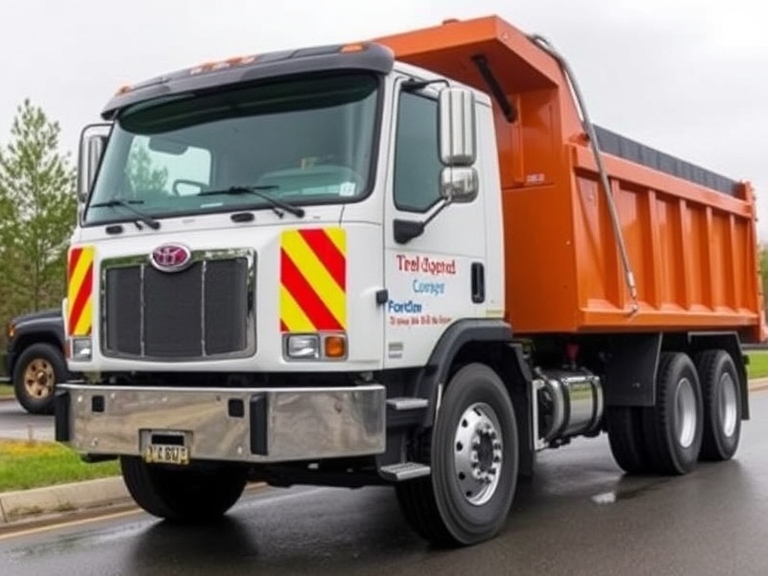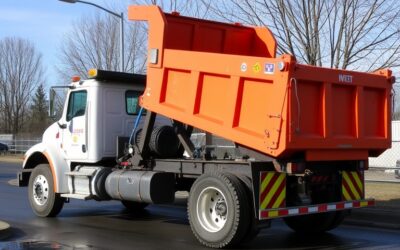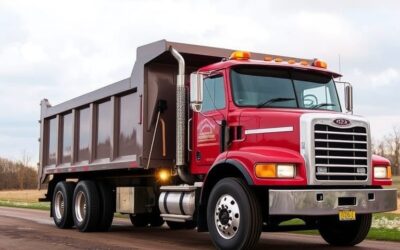Frameless dump trucks are crucial for many heavy-duty jobs, but their unique design makes them prone to tipping—creating safety risks and costly delays. Their design allows for more flexibility and less weight, making them highly efficient for certain tasks. However, these benefits come with challenges. Frameless dump trucks are prone to tipping over due to their unique structure, which can lead to dangerous accidents, costly repairs, and project delays. Ensuring their stability and safety is essential for smooth operations.
One of the best ways to protect frameless dump trucks from tipping is by using anti-tip devices. These devices are designed to monitor the truck’s stability in real time and act quickly to prevent accidents. They can automatically lower the dump bed if it senses an imbalance, reducing the risk of a tip-over. Installing these devices can greatly enhance the safety and efficiency of your operations. In this article, we will explore the unique challenges faced by frameless dump trucks, the key features of anti-tip devices, and how these devices can improve safety and stability. Lastly, we will provide practical steps to implement anti-tip devices in your fleet. This comprehensive guide aims to help you understand the importance of anti-tip devices and how they can protect your investment in frameless dump trucks.
Understanding the Unique Challenges of Frameless Dump Trucks
Frameless dump trucks, with their lighter design and flexibility, offer many benefits—but their lack of a frame also increases tipping risks. They don’t have a traditional frame to support the truck bed, which allows for greater load capacity and flexibility. However, this design also presents specific challenges that need careful attention.
One of the major issues is stability. Due to their frameless design, these trucks are more prone to tipping over, especially when the load is uneven or if the truck is on an incline. The lack of a supportive frame means the center of gravity can shift more easily, increasing the risk of a tip-over. This makes it crucial to monitor load distribution and truck positioning continuously.
Another challenge is maneuverability. Frameless dump trucks can be harder to control, especially when fully loaded. The absence of a frame can cause the truck to sway or become unsteady during sharp turns or sudden stops. This can not only slow down work but also increase the chances of accidents. Understanding these challenges helps underscore the need for effective anti-tip solutions to ensure safety and efficiency.
Key Features of Anti-Tip Devices
Anti-tip devices tackle the unique tipping risks of frameless dump trucks with these key features: One of the key features is real-time stability monitoring. These devices use sensors to continuously check the truck’s tilt angle and load distribution. If the system detects that the truck is leaning too much to one side, it sends immediate alerts to the driver. Another important feature is the automatic lowering mechanism. When a potential tip-over is detected, the anti-tip device can lower the dump bed automatically. This action helps to quickly reduce the center of gravity, making the truck more stable and less likely to tip. This feature is especially useful when unloading materials or operating on uneven ground.
Visual and audio alerts are also essential components. Anti-tip devices can provide clear warnings through lights and sounds, helping drivers react quickly to potential hazards. These alerts ensure that drivers are aware of any stability issues and can take corrective measures promptly. By incorporating these key features, anti-tip devices significantly enhance the safety and performance of frameless dump trucks.
How Anti-Tip Devices Enhance Safety and Stability
Anti-tip devices work around the clock to keep your frameless dump trucks safe and stable. Here’s how: One way they achieve this is through continuous monitoring. The sensors embedded in the device keep a constant watch on the truck’s tilt and load balance. This continuous feedback helps the operator stay aware of any impending risks, making it easier to take corrective action.
Another significant advantage is the automatic response feature. When the sensors detect a potential tip-over, the anti-tip device can quickly lower the dump bed. This immediate action reduces the risk of accidents by maintaining a lower center of gravity. It’s especially useful when the truck is navigating uneven terrain or unloading materials, which are critical moments where balance is key.
Driver alerts also play a crucial role. The visual and auditory warnings provided by anti-tip devices ensure that operators are aware of any stability issues. These alerts help drivers make quick decisions to avoid tip-overs. By implementing these safety features, anti-tip devices ensure that frameless dump trucks operate more safely and efficiently, reducing the risk of accidents and downtime.
Steps to Implementing Anti-Tip Devices in Your Fleet
Here’s how to implement anti-tip devices in your fleet for maximum safety: First, assess your needs. Determine how many trucks will require the anti-tip device and identify the specific challenges each truck faces. Understanding your fleet’s unique needs will help you choose the best anti-tip device for the job.
Next, focus on installation. Proper installation is crucial for the device to work effectively. Make sure to follow the manufacturer’s instructions carefully and consider professional help if needed. Incorrect installation can lead to malfunctioning, rendering the device ineffective.
Training is another important step. Operators must understand how the anti-tip device works and how to respond to its alerts. Conduct training sessions to ensure every driver knows how to use the device correctly. Regular refresher courses can also help keep safety front of mind for your team.
Finally, perform regular maintenance. Like any other equipment, anti-tip devices need upkeep to function properly. Schedule regular inspections and maintenance to ensure all components are in good working condition. Regular maintenance will extend the life of the device and ensure it continues to protect your trucks effectively.
Conclusion
Frameless dump trucks are vital but come with tipping risks. Anti-tip devices are the smart solution for keeping them safe and efficient, preventing accidents and downtime. Addressing these risks with an anti-tip device is a smart way to enhance safety and stability. These devices offer continuous monitoring, automatic adjustments, and immediate alerts, all of which help keep your operations running smoothly and safely.
By understanding the key features of anti-tip devices and following the steps to implement them in your fleet, you can reduce accidents and improve efficiency. Proper installation, thorough training, and regular maintenance are crucial to make the most of these safety tools.
Investing in anti-tip devices demonstrates a commitment to safety and efficiency. If you’re looking to protect your frameless dump trucks and ensure smooth operations, contact Wink Anti-Tip today for more information on how our advanced anti-tip devices can benefit your fleet. Let’s work together to enhance the safety of your operations.





